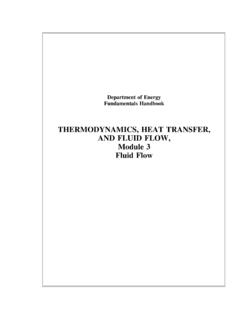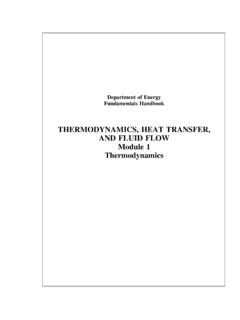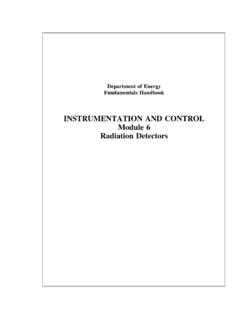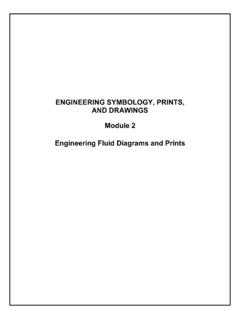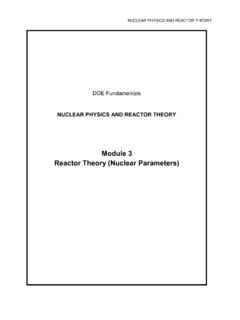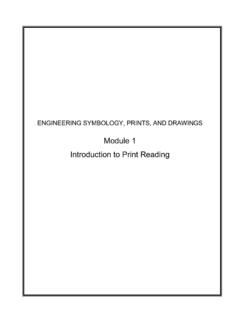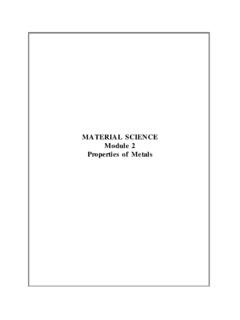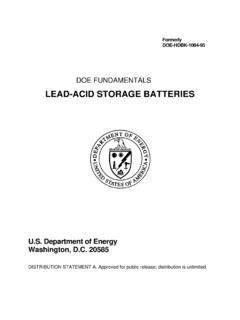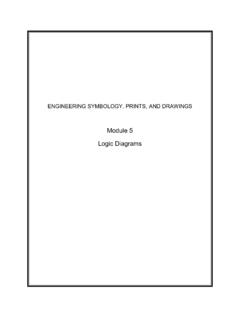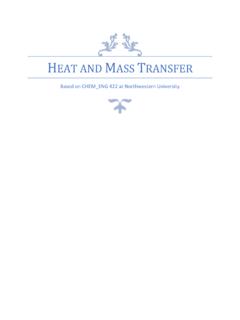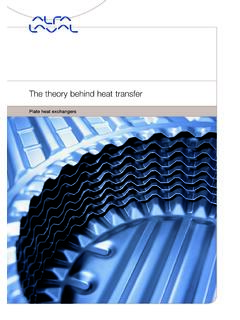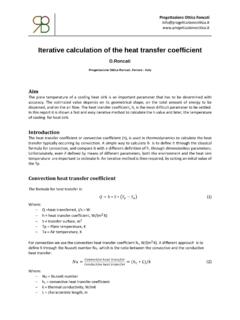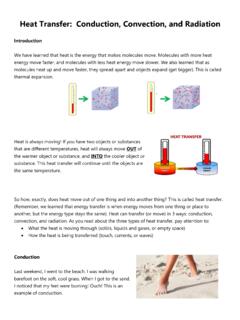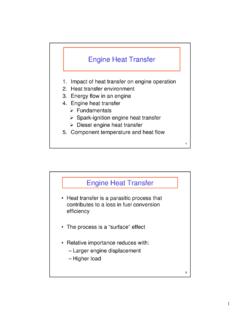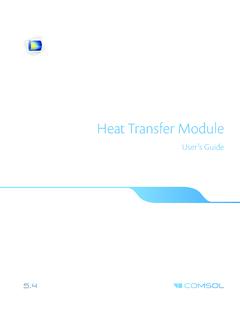Transcription of THERMODYNAMICS,THERMODYNAMICS, HEAT HEAT …
1 Department of EnergyFundamentals HandbookTHERMODYNAMICS,THERMODYNAMICS, HEATHEAT transfer , transfer ,ANDAND FLUIDFLUID FLOW,FLOW,ModuleModule 22 HeatHeat TransferTransferHeat TransferTABLE OF CONTENTSTABLE OF CONTENTSLIST OF iiiLIST OF viiHEAT transfer 1 heat and 1 heat and 2 Modes of Transferring 2 heat 3 Thermal 3 Log Mean Temperature 3 Convective heat transfer 4 Overall heat transfer 4 Bulk 5 CONDUCTION heat 6 Conduction-Rectangular 7 Equivalent Resistance 9 Electrical 10 Conduction-Cylindrical 17 CONVECTION heat 18 Overall heat transfer 20 Convection heat 25 RADIANT heat 26 Thermal 26 Black Body 27 Rev. 0 Page iHT-02 TABLE OF CONTENTSHeat TransferHT-02 Page iiRev. 0 TABLE OF CONTENTS (Cont.) radiation Configuration 29 heat 30 heat 30 Parallel and Counter-Flow 31 Non-Regenerative heat 34 Regenerative heat 34 Cooling Towers.
2 35 Log Mean Temperature Difference Application to heat 36 Overall heat transfer 39 BOILING heat 40 Nucleate 40 Bulk 41 Film 41 Departure from Nucleate Boiling and Critical heat 43 heat 44 heat 44 Flux 46 Thermal 47 Average Linear Power 47 Maximum Local Linear Power 48 Temperature 48 Volumetric Thermal Source 50 Fuel Changes During Reactor 51 DECAY 52 Reactor Decay heat 52 Calculation of Decay 53 Decay heat 55 Decay heat 57 heat TransferLIST OF FIGURESRev. 0 Page iiiHT-02 LIST OF FIGURESF igure 1 Conduction Through a 2 Equivalent 3 Cross-sectional Surface Area of a Cylindrical 4 Composite Cylindrical 5 Pipe Insulation 6 Overall heat transfer 7 Combined heat 8 Typical Tube and Shell heat 9 Fluid Flow 10 heat Exchanger Temperature 11 Non-Regenerative heat 12 Regenerative heat 13 Boiling heat transfer 14 Axial Flux 15 Radial Flux 16 Axial Temperature 17 Radial Temperature Profile Across a Fuel Rod and Coolant OF TABLESHeat TransferLIST OF TABLESNONEHT-02 Page ivRev.
3 0 heat TransferREFERENCESREFERENCESVanWylen, G. J. and Sonntag, R. E., Fundamentals of Classical ThermodynamicsSI Version, 2nd Edition, John Wiley and Sons, New York, ISBN , Frank, Principles of heat transfer , 3rd Edition, Intext Press, Inc., NewYork, ISBN , J. P., Thermodynamics, McGraw-Hill, New , Victor, L., Fluid Mechanics, 5th Edition, McGraw-Hill, New York, , W. C. and Perkins, H. C., Engineering Thermodynamics, 2nd Edition,McGraw-Hill, New York, ISBN , J. L., Engineering Mechanics Statics and Dynamics, John Wiley andSons, New York, ISBN , P. J. Conduction heat transfer , Addison-Wesley Pub. Co., , J. P., heat transfer , 3rd Edition, McGraw-Hill, New , J. G. and Katz, D. L., Fluid Dynamics and heat transfer , McGraw-Hill,New , W. and London, A. L., Compact heat Exchangers, 2nd Edition, McGraw-Hill, New , J. A., Engineering radiation heat transfer , Holt, Rinehart and WinstonPublish.
4 , New , E. M. and Cess, R. E., radiation heat transfer , Brooks/Cole , Belmont, , D. C. and Morgan, N. R., Radiant-Interchange Configuration Factors,Tech. Note 2836, National Advisory Committee for , A. T. and Fox, R. W., Introduction to Fluid mechanics, 2nd Edition,John Wiley and Sons, New York, ISBN 0 Page vHT-02 REFERENCESHeat TransferREFERENCES (Cont.)Zucrow, M. J. and Hoffman, J. D., Gas Dynamics , John Wiley and Sons,New York, ISBN Company, Flow of Fluids Through Valves, Fittings, and Pipe, Crane Paper No. 410, Chicago, Illinois, , Anthony, Fluid Power with Applications, Prentice-Hall, Inc., NewJersey, ISBN , T. G. and Buck, N. L., Mechanical Measurements, Addison-WesleyPublish Co., , Graham, One-Dimensional Two-Phase Flow, McGraw-Hill, New York, , W. and Crawford, M. E., Convective heat and Mass transfer , McGraw-Hill, New York, ISBN , J.
5 G., Convective Boiling and Condensation, McGraw-Hill, New York,ISBN Program for Nuclear Power Plant Personnel, Volumes III and IV,Columbia, MD: General Physics Corporation, Library of Congress Card #A326517, , Virgel Moring and Simmang, Clifford Max, Thermodynamics, MacMillanPublishing Co. Inc., New viRev. 0 heat TransferOBJECTIVESTERMINAL the operating conditions of a thermodynamic system and the necessaryformulas,EVALUATEthe heat transfer processes which are difference between heat and difference between heat and Second Law of Thermodynamics and how it relates to heat three modes of heat following terms as they relate to heat mean temperature heat transfer heat transfer Fourier s Law of Conduction,CALCULATEthe conduction heat flux in arectangular coordinate the formula and the necessary values,CALCULATEthe equivalent Fourier s Law of Conduction,CALCULATEthe conduction heat flux in acylindrical coordinate the formula for heat transfer and the operating conditions of the system.
6 CALCULATEthe rate of heat transfer by the following terms relate to radiant heat body configuration factorRev. 0 Page viiHT-02 OBJECTIVESHeat TransferENABLING OBJECTIVES (Cont.) difference in the temperature profiles for counter-flow and parallel flowheat differences between regenerative and non-regenerative heat the temperature changes across a heat exchanger,CALCULATEthe log meantemperature difference for the heat the formulas for calculating the conduction and convection heat transfercoefficients,CALCULATEthe overall heat transfer coefficient of a process that occurs in the following regions of the boiling heat film from nucleate boiling (DNB) heat fluxHT-02 Page viiiRev. 0 heat TransferOBJECTIVESTERMINAL the operating conditions of a typical nuclear reactor,DESCRIBEthe heat transferprocesses which are power generation process in a nuclear reactor core and the factors thataffect the power relationship between temperature, flow, and power during operation ofa nuclear following enthalpy rise hot channel linear power heat flux hot channel generation rate of a thermal source average linear power density for an average reactor core fuel typical reactor core axial and radial flux typical reactor core fuel rod axial and radial temperature term decay the operating conditions of a reactor core and the necessary formulas,CALCULATEthe core decay heat categories of methods for removing decay heat from a reactor 0 Page ixHT-02 heat TransferIntentionally Left BlankHT-02 Page xRev.
7 0 heat TransferHEAT transfer TERMINOLOGYHEAT transfer TERMINOLOGYTo understand and communicate in the thermal science field, certain terms andexpressions must be learned in heat the difference between heat and the difference between heat and the Second Law of Thermodynamics andhow it relates to heat the three modes of heat the following terms as they relate to mean temperature heat transfer heat transfer temperatureHeat and TemperatureIn describing heat transfer problems, students often make the mistake of interchangeably usingthe terms heat and , there is a distinct difference between the a measure of the amount of energy possessed by the molecules of a is a relative measure of how hot or cold a substance is and can be used to predict the directionof heat symbol for temperature is common scales for measuringtemperature are the Fahrenheit, Rankine, Celsius, and Kelvin temperature energy in transit.
8 The transfer of energy as heat occurs at the molecular level as a resultof a temperature difference. heat is capable of being transmitted through solids and fluids byconduction, through fluids by convection, and through empty space by radiation . The symbolfor heat is Q. Common units for measuring heat are the British Thermal Unit (Btu) in theEnglish system of units and the calorie in the SI system (International System of Units).Rev. 0 Page 1HT-02 heat transfer TERMINOLOGYHeat TransferHeat and WorkDistinction should also be made between the energy termsheatandwork. Both represent energyin transition. Work is the transfer of energy resulting from a force acting through a is energy transferred as the result of a temperature difference. Neither heat nor work arethermodynamic properties of a system. heat can be transferred into or out of a system and workcan be done on or by a system, but a system cannot contain or store either heat or work.
9 Heatinto a system and work out of a system are considered positive a temperature difference exists across a boundary, the Second Law of Thermodynamicsindicates the natural flow of energy is from the hotter body to the colder body. The Second Lawof Thermodynamics denies the possibility of ever completely converting into work all the heatsupplied to a system operating in a cycle. The Second Law of Thermodynamics, described byMax Planck in 1903, states that:It is impossible to construct an engine that will work in a complete cycle andproduce no other effect except the raising of a weight and the cooling of second law says that if you draw heat from a reservoir to raise a weight, lowering the weightwill not generate enough heat to return the reservoir to its original temperature, and eventuallythe cycle will stop. If two blocks of metal at different temperatures are thermally insulated fromtheir surroundings and are brought into contact with each other the heat will flow from the hotterto the colder.
10 Eventually the two blocks will reach the same temperature, and heat transfer willcease. Energy has not been lost, but instead some energy has been transferred from one blockto of Transferring HeatHeat is always transferred when a temperature difference exists between two bodies. There arethree basic modes of heat transfer :Conductioninvolves the transfer of heat by the interactions of atoms or molecules of amaterial through which the heat is being the transfer of heat by the mixing and motion of macroscopicportions of a , or radiant heat transfer , involves the transfer of heat by electromagneticradiation that arises due to the temperature of a three modes of heat transfer will be discussed in greater detail in the subsequent chaptersof this 2 Rev. 0 heat TransferHEAT transfer TERMINOLOGYHeat FluxThe rate at which heat is transferred is represented by the symbol.
